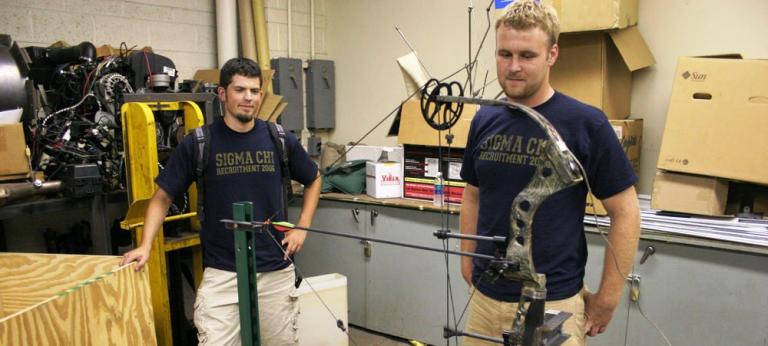
As if he weren't busy enough with 24 credit hours, fraternity charity work, joining the Order of the Engineer Honor Society, writing his thesis and job hunting, Kettering senior Justin Keiffer, of Carson City, Mich., is conducting a research project on the performance of hunting bows - and he's not even getting academic credit for the research.
Keiffer was inspired to do the research on deflection and reduced accuracy in hunting bows by a video from Easton Sports, manufacturer of sporting equipment, on deflection and reduced accuracy in hunting bows during a class with Dr. Henry Kowalski, professor of Mechanical Engineering.
A recreational bow hunter himself, Keiffer knew someone who knew someone who put him in touch with Custom Shooting Systems in Virginia. He approached them with a proposal to conduct tests on how well Bow Tunerz improved bow performance, and they sent him a bow to test.
Keiffer wanted to determine the difference in hand shock between hunting bows outfitted with Tunerz and those without. Tunerz are small rubber devices designed to absorb the vibrations that are normally transmitted to the hand holding the bow upright, after the bow is shot.
"The biggest vibration felt by the shooter is in the hand," said Keiffer, "as the limbs go from a parallel position back to an upright position it makes the bow jump forward, compromising accuracy and precision."
Tunerz are used on the strings of a bow and on the bow itself on the risers and limbs (for the non-bow user that translates to the area where the hand holds the bow or to the outer ends that flex when the bow is drawn).
Originally, the research was used as a project in Kowalski's Experimental Mechanics class. Keiffer and project partner Josh Goudzwaard, of Muskegon, Mich., were intrigued by the results of their class project and, wanting to take their testing further, decided to continue testing even though they are receiving no academic credit for the research.
"Our goal is to find out how much Tunerz can eliminate hand shock and other vibrations in the bow and reduce noise levels too," Keiffer said. Testing involved firing different weight arrows from a 60-pound bow mounted on a test stand with a mechanical trigger. The test stand and trigger ensured consistent conditions for firing. Arrows fired included 300, 360, 420, 480 and 540-grain, or 5, 6, 7, 8 and 9-grains per pulling pound times the 60-pound bow. A grain is a unit of weight measurement used for arrows and bullets, according to Keiffer.
Their initial findings showed that hand shock when firing lighter weight arrows is more affected by Tunerz than heavier weight arrows. Using a carbon arrow weighing 300 grains, a bow dampened with Tunerz showed a marked reduction in vibration.
"With the light arrows, representing five to six grains-per-pound of pulling force, the Tunerz reduced vibration and shock by up to 2.5 times the normal rate," Keiffer said. "Once the arrow weight reached seven grains per pound of pulling force, the tuners did not seem to reduce hand shock, and at eight to nine grains per pound of pulling force they actually increased hand shock and vibration," he said.
But in most cases, the seven, eight and nine grain-per-pound arrows had less hand shock to begin with than the lighter arrows, according to Keiffer. He speculated that this was related to arrow speed and the bow using more energy to move the heavier masses.
According to Keiffer, the more vibration induced deflection (flex) that can be eliminated in the limbs of the bow by using Tunerz, the longer the bow will last, and, it will stay in tune better over longer periods of time as well as not vibrating components on the bow loose such as the rest, sight, quiver and other attachments.
To further understand the physics underlying the bow used in the testing, Keiffer and Goudzvaard plan to work with Dr. Dan Russell, associate professor of Physics at Kettering, to benchmark the acoustical properties of the bow. Russell agreed to test the bow in the same way he tests composite softball bats to determine where it vibrates the most. "This will give us a general idea of where to put the Tunerz on the limbs and risers in future tests," said Keiffer.
Even though he is not getting academic credit for all his hard work, Keiffer will get to keep the bow used for testing in exchange for sharing his results With Custom Shooting Systems. "I've wanted a new bow for a while so it's a win-win situation - I got a new bow and they (Custom Shooting Systems) got some information about their product they plan to use in future advertising," said Keiffer.
He may also get a job out of the deal. Because of his research, Keiffer has been approached by sporting equipment manufacturers about working for them in research and development.
If that doesn't pan out, he can always fall back on his other research project - his work with three other Kettering students researching different blends of bio-fuels and retrofitting their diesel VW Rabbits to run on used vegetable oil from local bakeries. Their efforts netted them an unfunded research project with Bosch last year and continues to save them a lot of money at the pump.
Written by Dawn Hibbard
810-762-9865
dhibbard@kettering.edu